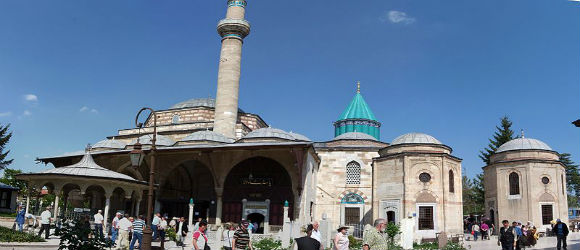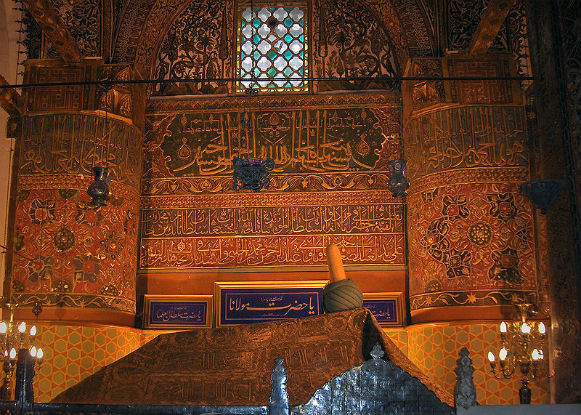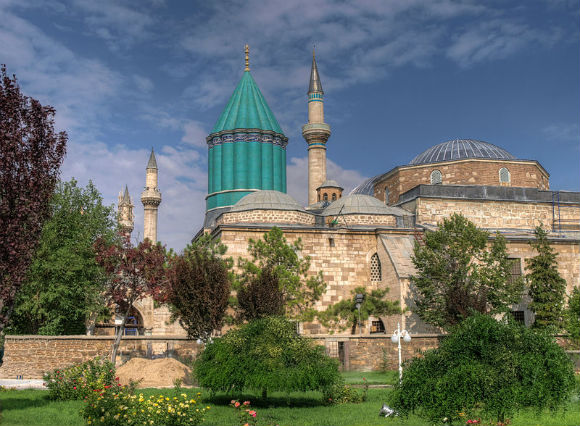The Mevlana Museum also known as the Green Mausoleum or Green Dome, is the original lodge of the Mevlevi Whirling Dervishes, a mystical Sufi Muslim group. It containes the tomb and shrine of the Mevlana, or Rumi, which remains an important place of pilgrimage.
History
Sultan ‘Ala’ al-Din Kayqubad, the Seljuk sultan who had invited Mevlana to Konya, offered his rose garden as a fitting place to bury Baha’ ud-Din Walad (or Bahaeddin Veled), the father of Mevlana, when he died in 1231. When Mevlana himself died on December 17, 1273, he was buried next to his father.
Mevlana’s successor Hüsamettin Çelebi built a mausoleum (Kubbe-i-Hadra) over the grave of his master. The Seljuk construction, under architect Behrettin Tebrizli, was finished in 1274. Gürcü Hatun, the wife of the Seljuk Emir Suleyman Pervane, and Emir Alameddin Kayser funded the construction.
The cylindrical drum of the of the dome originally rested on four pillars. The conical dome is covered with turquoise faience. Several sections were added until 1854. Selim I decorated the interior and performed the woodcarving of the catafalques.
A decree by Ataturk in September 1925 dissolved all Sufi brotherhoods in Turkey. On April 6, 1926, another decree ordered that the Mevlana mausoleum and dervish lodge be turned into a museum. The museum opened on March 2, 1927.
Special permission granted by the Turkish government in 1954 allowed the Mawlawi dervishes of Konya to perform their ritual dances for tourists for two weeks each year. Despite government opposition the order has continued to exist in Turkey as a religious body. The tomb of Rumi, although officially part of a museum, attracts a steady stream of pilgrims.
What to See
The dervish lodge (tekke) includes a semahane, where the ritual sema or whirling ceremony takes place, a sadirvan for ritual ablutions, a library, living and teaching quarters, and the mausoleum housing the tomb of Celaleddin Rumi, founder of the sect and later awarded the honorable title of Mevlana. His epitaph reads: “Do not seek our tombs on this earth – our tombs are in the hearts of the enlightened.”
The mausoleum room is highly ornamented with Islamic script and enameled reliefs, and contains the tombs of several of the more important figures of the dervish order. The main tomb enclosed behind a silver gate crafted in 1597 is that of Mevlana. The tomb of his father, Bahaeddin Veled, is upright and adjacent to his son’s, a position that signifies respect.
The adjoining room, or the semihane, is now a museum of Mevlana memorabilia displaying musical instruments and robes belonging to Mevlana, along with Selçuk and Ottoman objects like gold-engraved Korans from the 13th century. Among the fabulous ancient prayer rugs is the most valuable silk carpet in the world.
Mevlana Museum, Konya,




Mawlana is one of the biggest islamic Sufi (Sufi, a Islam religious philosophy). Mystical movement within Islam that seeks to find divine love and knowledge through direct personal experience of Allah(C.C.). It consists of a variety of mystical paths that are designed to ascertain the nature of mankind and Allah (C.C.) and to facilitate the experience of divine love and…
This place is much more than a museum… It's almost a pilgrimage destination: it's imposing, it's divine and as all pilgrimage destinations, it's way too crowded, especially if you visit it between 7th of 17th of December every year… This is one of the buildings where the Seljuk architecture is best exemplified, the domes from a distance especially at night…
I knew of Rumi and I had seen the Whirling Dervishes. Until Konya, I had not put the two together. I enjoyed the time here, learned quite a bit from the displays and the museum. The guards near Rumi's memorial tried hard to answer our questions in English. A fascinating stop.
If you're a Rumi person, this is a really cool experience. It will be crowded, so be ready for that. No photos allowed inside because it is a holy site. If you go, do some homework before hand so you know what you're looking at, or travel with a guide.
Although I didnt understand everything in this mystical museum the power of Rumi's story is evident in the faith of the visitors to this place.
Very busy but well worth a visit t better understand Rumi and Sufi mysticism. Popular with families and tourists alike. And you can take photos with flash to your heart's content, including Rumi's tomb inside the beautifully painted mosque museum. You do need to take off shoes and wear a scarf (women). There's a nice museum shop in the lush…
This is an fairly interesting place to look around even if you are not into the Muslim history etc. It only costs 3TL (I think) and makes a good 2-2.5 hr or so in order to take in so much of the Muslim history, Rumi, the mausoleum, dervish rituals , dance etc etc. If Konya happened to fit into your…
Been wanting to visit this place since I first fell in love with Rumi's poetry many years ago. Honestly didn't know what to expect, except for all the things that could be found online.
Came here with a friend last May with the help of a tour guide friend's instructions. A few minutes away from the otogar (bus terminal) by…
Distinctive look – interesting displays. Good – but pricey gift shop.
Unless you are a devotee of Rumi and his philosophy, this is probably not worth a detour unless you are going through Konya anyway. The museum has been upgraded since I was there a decade ago, but it is still somewhat artificial with mannequins in dioramas. The mausoleum with Rumi's sarcophagus is beautiful and worth the (reasonable) ticket price. There…